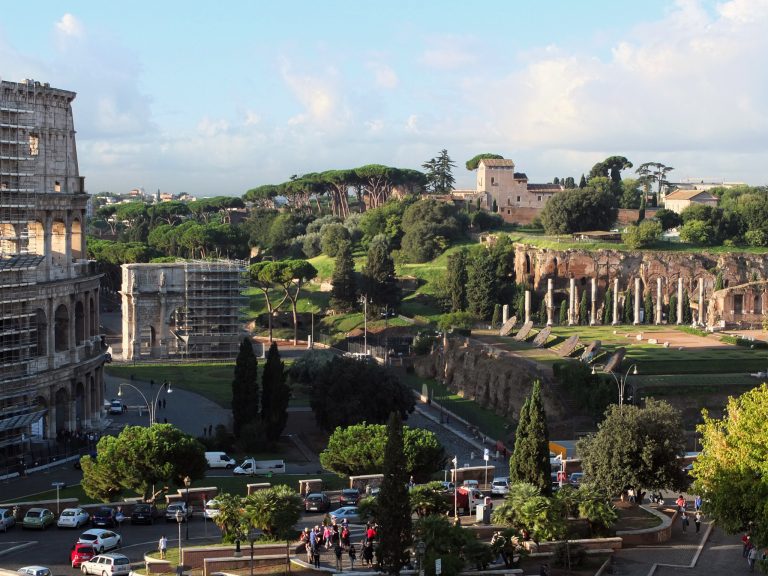 We often think of Rome as our second home. We know it well, from the ancient city to the Byzantine, Medieval, Renaissance, Baroque and post Unification of the late 19th century. We love Rome from prehistory to now history.
We often think of Rome as our second home. We know it well, from the ancient city to the Byzantine, Medieval, Renaissance, Baroque and post Unification of the late 19th century. We love Rome from prehistory to now history.
In the past few years, we’ve made the Monti our home. It’s a bit quieter and removed from the tourist chaos of Campo dei Fiori, Piazza Navona, Piazza di Spagna, Trastevere or now even the old Jewish Ghetto. Yes, tourists do come to the Monti. Technically the Coliseum and the Imperial Fori are in this zone.
From our terrace we see maps unfurling in the breeze as people try to find the Church of San Pietro in Vincoli to see Michelangelo’s 16th century statue of Moses on the tomb of Pope Julius II. Directional signs are affixed to walls these days, but most people are still having a hard time finding the church.
Tourists rarely venture around the back of the Coliseum away from the Via dei Fori Imperiale. It’s worth the look, just to walk up through the ruins of the Baths of Trajan on the Oppian Hill or to see the Ancient “Ludus” (Gladiator School) that was once attached to the great Amphitheatre. I’m sure it still is attached somewhere under the Piazza del Colosseo.
These days most of the Ludus is covered up by the Piazza del Colosseo, the Via Lubicana and the Via di San Giovanni in Laterano, now nicknamed “Gay Street”. Yes, the Gay residents of Rome have adopted the Gladiator School as their hang.
From our terrace we can pretty much see a day in the life of Rome.
We watch the costumed Centurions park their small Fiat chariots on via del Fagutale, grab their wooden swords and other props, fix their helmets to their heads and head off to work in the front of the Coliseum or along the Via dei Fori Imperiale.
We can see teenagers coming and going to the High School on Via Vittorio da Feltre and commuters and tourists arriving to the Metro B stop at the Coliseum.
Yes, it’s true, there are fewer tourists in Rome in September and October but fewer is a relative term when you’re in a city that gets about 12 million tourists a year.
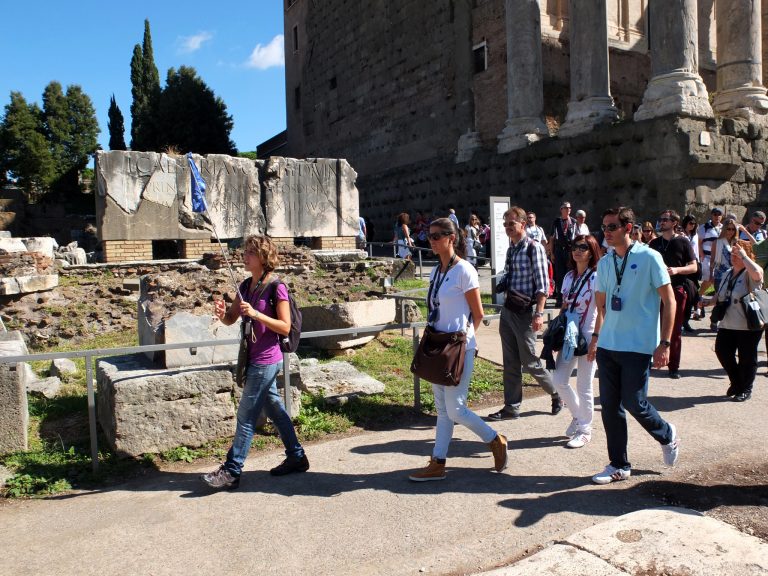 We watch the tour groups arrive by the coach load, coming in from nearby Cruise ships in the port of Civitavecchia, about an hour away. Their leaders armed with colorful flags, umbrellas or pompoms on a stick while the obedient ranks stumble across the broken stones of the 16th century streets trying to keep up. They’re fitted with identification badges or colorful scarves. They have earbuds in their ears connected to radio receiver hanging from their necks. This is the greatest technological introduction to tour groups. A few years back it was a shouting match between tours and in small places like the Stanze di Rafaello in the Vatican Museums it could be deafening (and really annoying) to other visitors. According to us, these earbud/radio receivers should be mandatory (by law) for all tour groups over 6 people.
We watch the tour groups arrive by the coach load, coming in from nearby Cruise ships in the port of Civitavecchia, about an hour away. Their leaders armed with colorful flags, umbrellas or pompoms on a stick while the obedient ranks stumble across the broken stones of the 16th century streets trying to keep up. They’re fitted with identification badges or colorful scarves. They have earbuds in their ears connected to radio receiver hanging from their necks. This is the greatest technological introduction to tour groups. A few years back it was a shouting match between tours and in small places like the Stanze di Rafaello in the Vatican Museums it could be deafening (and really annoying) to other visitors. According to us, these earbud/radio receivers should be mandatory (by law) for all tour groups over 6 people.
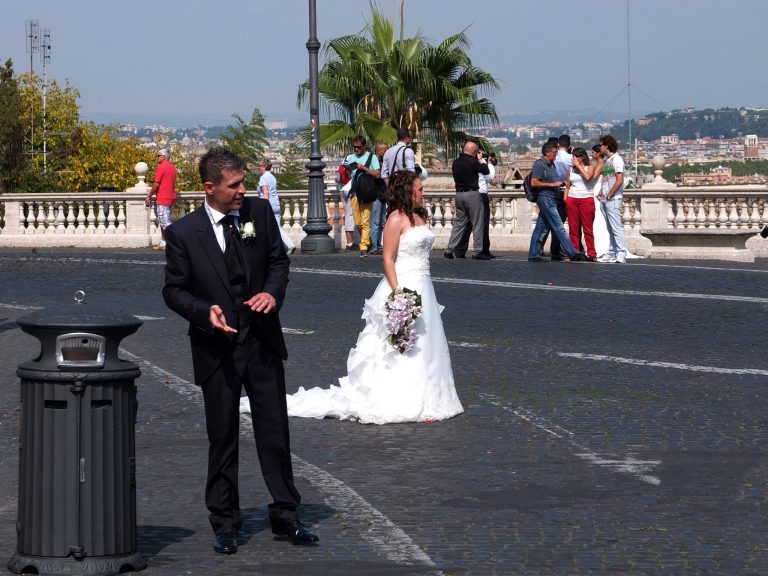 It’s September and yet we still see newly married couples posing for photos in front of the Coliseum, as well as the ancient Forum and the Campidoglio on the Capitoline Hill. We even saw a few wedding photo shoots up on the Janiculum Hill in front of the Aqua Paolo fountain. It’s a great view over the city from up there, pretty close to a bird’s eye view.
It’s September and yet we still see newly married couples posing for photos in front of the Coliseum, as well as the ancient Forum and the Campidoglio on the Capitoline Hill. We even saw a few wedding photo shoots up on the Janiculum Hill in front of the Aqua Paolo fountain. It’s a great view over the city from up there, pretty close to a bird’s eye view.
For the most part, the weather of late September, early October has been perfect, bright clear skies, warm days and slightly cool nights. The colors of Rome this time of year are amazing. The reds and oranges and burnt yellows have so much more depth than any other time of year.
From 64AD till the 1960’s, Rome was a city continually devouring itself. Her architecture is something like the Quantum Theory, one shape disassembles and becomes another. The glory that was ancient Rome was broken, pulverized and melted down in lime kilns to create the Christian Rome. You can still turn the corner and see old the ancient columns, capitals, pediments and lintels used in the construction of 16th and 17th century buildings.
These days, Rome is making a great effort to rediscover itself and preserve what’s left. Every year a new excavation site opens up to the public and every year other one or two close down. Some of them are published, some very few people ever even knew about. There are still lots of secret places in this city way off the tourist map. We’ve found a lot of them but it could take a lifetime to see them all. Lucky for us, we’re up for the task.
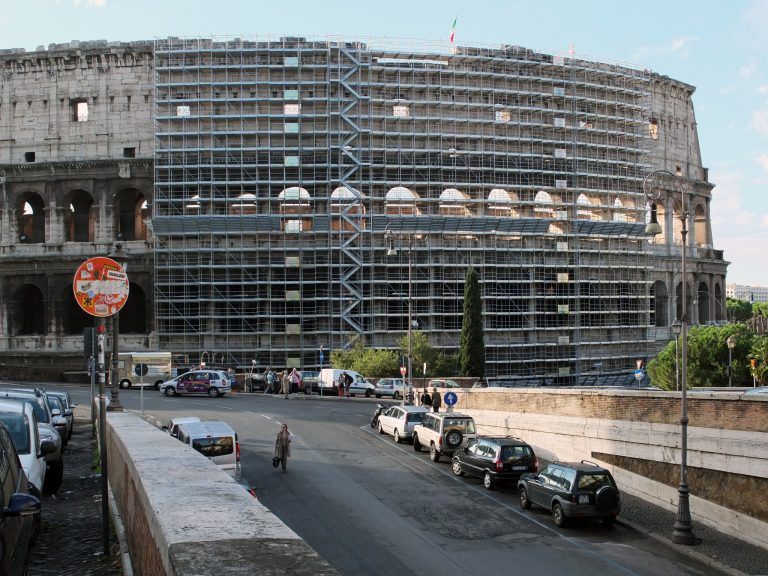 Scaffolding is going up on the Coliseum. The project has been delayed for at least a year since Diego Della Valle, the CEO of Tod’s leather goods gave 25 million euros (I’ve read the sum was 13 million to 30 million) towards to clean and repair parts of the great amphitheater. After-all, it hasn’t had a good washing in over 1,950 years.
Scaffolding is going up on the Coliseum. The project has been delayed for at least a year since Diego Della Valle, the CEO of Tod’s leather goods gave 25 million euros (I’ve read the sum was 13 million to 30 million) towards to clean and repair parts of the great amphitheater. After-all, it hasn’t had a good washing in over 1,950 years.
As of August 3rd 2013, only taxis and buses are allowed to drive near the Coliseum. This is the first phase of the plan Mayor Ignazio Marino, who is using his official position to make the Via Fori Imperiale a pedestrian street only.
It is foot traffic only on Sundays but if the Mayor gets his wish, this once main artery of rumbling traffic will end it’s over 80 year life since Mussolini built the grand thoroughfare in 1932. In the process he destroyed one of the most densely populated sections of the city, wiping out ancient Fori, quite a few Medieval Churches and leaving hundreds of people homeless.
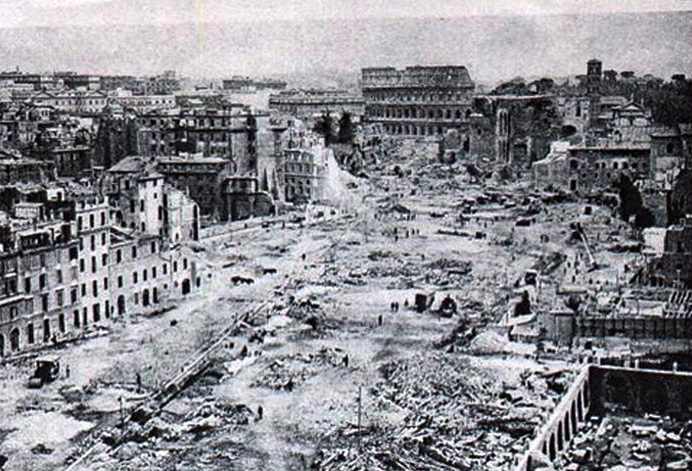 This photo is from the 1920’s when the street was being torn up to make room for the via dei Fori Imperiale.
This photo is from the 1920’s when the street was being torn up to make room for the via dei Fori Imperiale.
Mayor Marino, a former transplant surgeon, used the analogy of a person recovering from surgery, “the city had been sleeping and needed to wake up. After the shock, you go onto live a long productive life.”
Rome has one of the worst traffic problems in all of Western Europe. According to Mayor Marino, 97% of the adult population of Rome owns a car (compared to 34% in London). It’s so congested, the average speed of public transportation in the city is 9 miles per hour. Marino feels that closing the Via dei Fori Imperiale will hopefully not just help the life of the ancient monuments but will also encourage the Romans to leave the car at home and use public transport or walk.
Not all agree with the newly elected Mayor. The grand boulevard hosts over 1,600 vehicles per hour during the peak times. The rerouting of all these cars and trucks will spill over into the smaller neighborhoods and annoy the hell out of the inhabitants. Buses can longer park in front of the Coliseum. They’re currently lined up on the Oppian Hill, very close to the Basilica San Pietro in Vincoli. Well maybe the move will finally get people over to the Trajan Baths and the Michelangelo sculpture.
Opponents also argue that the Via dei Fori Imperiale is to Rome like the Champs-Elysées is to Paris. It’s one of the Grand Boulevards of Europe.
People all over the world react slowly to change, especially when it is forced on them.
It’s amazing the Coliseum and the Fori have endured the rumbling of large trucks and buses over the past 80 years without loosening some stones. To make matters even worse, the Coliseum Metro station has been rocking the foundations of the great Amphitheater since the 1950’s.
Now that the scaffolding has gone up, maybe the restoration team will be able to determine the extent of the vibration damage caused by large vehicles. Some consultants on the project have stated that the south side of the amphitheater has a 40cm (15.7”) lean. However, one has to remember, the massive amphitheater was built over a filled in lake and the lower levels still flood every year. It is highly unlikely they will try to support the lean with a new foundation similar to the structural support of the Leaning Tower in Pisa but who knows?
The project is expected to last three years, but given the time it took to get the thing started, and the current political problems of Rome, it could take a lot more.
We met a Restoration Biologist at a restaurant a few nights ago. She was in Rome working on a problem of ridding biological microbes from very old tapestries. We asked her “how does one clean the Coliseum?” She winced when I mentioned muriatic acid. She told us it was too harsh and would eat into the stone. She shook her head when we asked about pressurized water, saying it would damage the foundation of the stones. She suggested that they would most likely use ammonia bicarbonate or something similar. They’ll take samples of the dirt, analyze the PH balance and then decide.
Aside from the Coliseum covered in steel, the Arch of Constantine is also getting a good cleaning and the new Metro C line is being excavated. It should be completed by 2020. The metro C stop at the Coliseum will also include a museum of all the pieces they discovered during the dig.
Although Metro C is making it difficult for vehicles in the city, the project is really exciting. Archeologists have not had an opportunity to see what is under the Via Fori dei Imperiale since the 1920 and during that dig, everything was pulled up and removed so quickly it was never labeled correctly. Unfortunately we have no idea where most of the pieces came from or what they belonged to. This could reveal the most important discoveries of the Fori in hundreds of years.
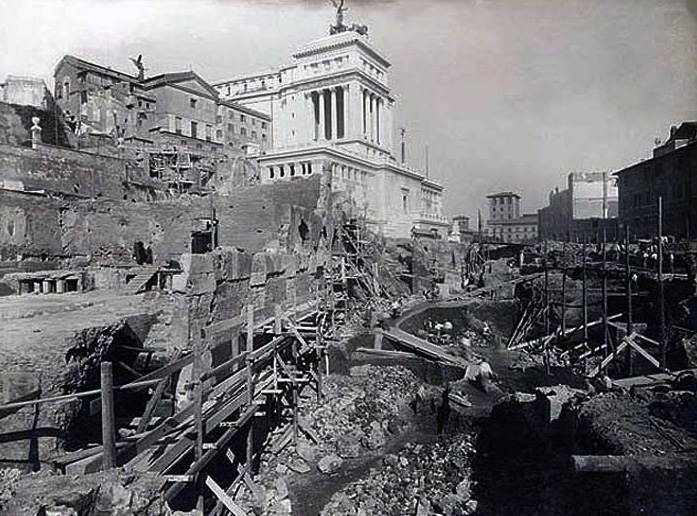 Metro C was supposed to make stops at Piazza Venezia and Largo Argentina but in the initial excavations they architects and engineers discovered too many archeological remains to continue. In 2009, the dig by Piazza Venezia revealed the remains of Emperor Hadrian’s Athenaeum, a school for Intellectuals. It was covered, along with many of the renaissance Palazzi destroyed to built the (hideously controversial) glorification Monument of King Vittorio Emanuele II.
Metro C was supposed to make stops at Piazza Venezia and Largo Argentina but in the initial excavations they architects and engineers discovered too many archeological remains to continue. In 2009, the dig by Piazza Venezia revealed the remains of Emperor Hadrian’s Athenaeum, a school for Intellectuals. It was covered, along with many of the renaissance Palazzi destroyed to built the (hideously controversial) glorification Monument of King Vittorio Emanuele II.
The Metro C from the Coliseum to the Piazza Venezia (a 10 minute walk) was estimated to cost over 300 million euros. I’ve also heard of a proposed Metro Line D coming soon. Rome will be turned inside out.
Scaffold goes up and down all the time in this city. The Eternal city is one Eternal Restoration. New steel has gone up on the lower floors of Trajan’s Market and across the Flavian Palace on the Palatine Hill.
The good news is what goes up will eventually come down and the result is worth the wait.
 The scaffold and fence covering a section of the Circus Maximus has come down to reveal an ancient section of what was the largest of the stadiums in Ancient Rome.
The scaffold and fence covering a section of the Circus Maximus has come down to reveal an ancient section of what was the largest of the stadiums in Ancient Rome.
New brick has filled in many of the gaps in the old stone and it doesn’t take any strain of imagination to see the portals and steps. This is the only spot of the Circus that will be revealed. We wish they would uncover more of it.
During the height of the ancient Empire it was 2,037’ long (621 m) x 387’ wide (118m) and could hold 150,000 spectators. The Coliseum had a capacity of around 60,000. The Circus was big.
If you get around Rome to see the Obelisks (a great day’s walk), the obelisk in front of the Basilica of St John in Lateran and the one in Piazza del Popolo came from the “Spina’, the central dividing curb of the Circus Maximus. These will give you a good idea of the scale of everything.
The Circus is now a large public space. It used to be a favorite spot for joggers running the course of the ancient chariots. Outdoor video screens were set up here in 2006 to celebrate the Italian World Cup Victory. They were set up again in 2010 when Italy was in the semi-final against Spain but there was no joy in Roma after this one.
From the 15th to the 17th century the Circus Maximus became a junkyard of raw materials used to build the grandeur that became Christian Rome. Limestone, marble and granite , porphyry and basalt stones and statues were crushed and melted down at 1000°C (1832°F) , all reformed into new building materials for the new Christian city. As much as I wish more of the ancient monuments were saved, I am grateful for what is still here and for all the efforts to reveal more of it.
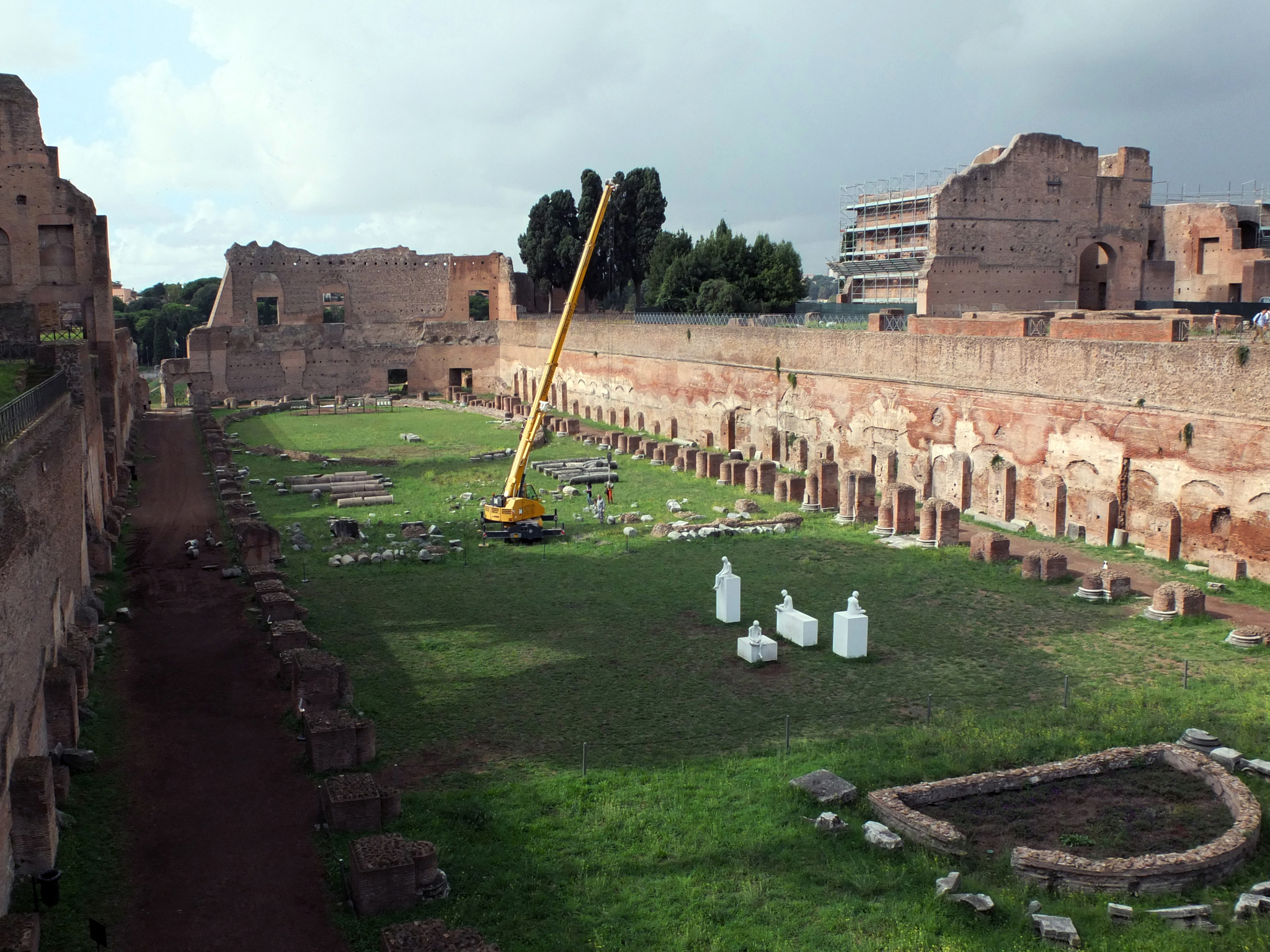 New archeological sites are always re-opening on the Palatine Hill, the most famous hill in ancient Rome. The Palatine was the home of the Kings of Rome through the Emperors. Even the Ostrogoth Theodoric lived in the grand Palace up on the Hill in the 5th century. By all accounts, he was the last resident of note.
New archeological sites are always re-opening on the Palatine Hill, the most famous hill in ancient Rome. The Palatine was the home of the Kings of Rome through the Emperors. Even the Ostrogoth Theodoric lived in the grand Palace up on the Hill in the 5th century. By all accounts, he was the last resident of note.
Anyone who was anyone sought an address up on the Palatine. It was the home to the rich and famous since 500 BC.
The Roman Politician, lawyer, writer and orator, Marcus Tillius Cicero once wrote that he had finally made it because he finally had a home on the Palatine, although when he left Rome in a self imposed exile in 58 BC for the illegal execution of Roman Citizens attempting to overthrow the Republic, his villa was burned down by thugs paid by his political enemy, Clodius Pulcher.
Clodius was killed in 52 BC in a street brawl when the political agitator, Titus Milo and his gang of thuggies attacked Clodius and his gang on the way to the Forum. I know I’m getting a bit off the subject here but it all ties together in a very interesting chain of events.
The grieving supporters of Clodius decided to build his funeral pyre inside the Curia (Senate House), which turned out to be a really bad idea. The flames ignited the building and burned it down. The new location for the Roman Senate was moved to one of the buildings near the entrance to the new (finished in 55 BC) Theatre of Pompey (now largo Argentina and the Campo dei Fiori). It was in front of this building in 44 BC where Julius Caesar was killed. The Curia in the Ancient Forum was rebuilt, and yes, you can get inside. It’s part of the Forum/Palatine/Coliseum ticket. However, this is not the Curia (Senate House) where Caesar was killed.
Cicero moved back to Rome in 56 BC but after a few more bad alliances and his participation in the murder of Julius Caesar, he was finally killed in 43 BC, his head and hands nailed to the door of the Curia.
The Palatine Hill is the site is where the fabled she wolf found Romulus and Remus and nursed them in the cave known as the Lupercale. Every year on February 15th, the ancient priests would kill a dog and two goats and smear their blood on the foreheads of two boys (representing Romulus and Remus) of two noble families in the Lupercalia Celebration somewhere near the famous Lupercale. The annual festival actually lasted until 494, when Pope Gelasius finally put it to rest.
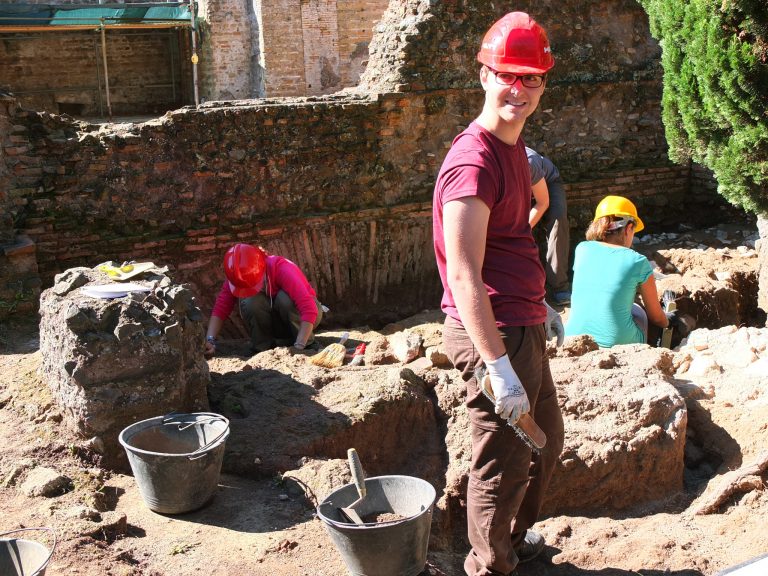 In 2007, archeologists discovered what could very likely be the Lupercale of Romulus and Remus beneath the House of Augustus. The site could go back to the 8th century BC. I’ve seen photos of it, a shell encrusted grotto, but it’s never been opened to the public.
In 2007, archeologists discovered what could very likely be the Lupercale of Romulus and Remus beneath the House of Augustus. The site could go back to the 8th century BC. I’ve seen photos of it, a shell encrusted grotto, but it’s never been opened to the public.
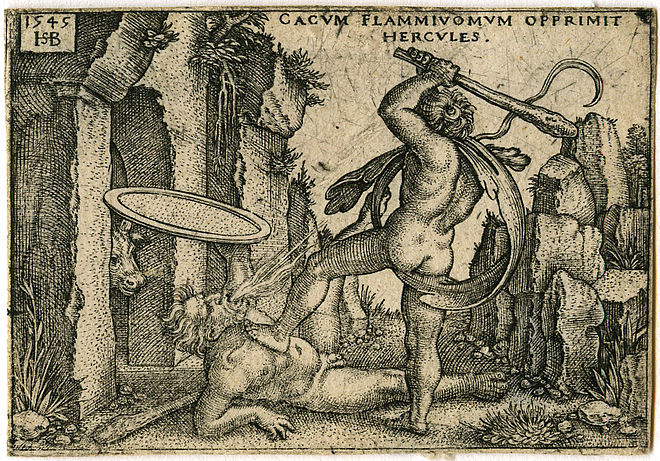 This might also (possibly) be where Hercules defeated the fire breathing human eating Cacus. According to the legend, Hercules clubbed Cacus so hard, the blow formed a cleft into the hill. It was later filled with steps of stone to make the Scala Caci (Steps of Cacus). The remains of the steps are gone. They once led down to the house of Romulus and later to the first stone theater of Ancient Rome (2nd century BC), the theater of Cassius Longinus, which didn’t last very long after it was declared too lewd by the laws of “Pudicitia” (sexual ethics). The location of the Caci Steps is between the Houses of Augustus and Livia. Hopefully the archeologists will keep looking for it.
This might also (possibly) be where Hercules defeated the fire breathing human eating Cacus. According to the legend, Hercules clubbed Cacus so hard, the blow formed a cleft into the hill. It was later filled with steps of stone to make the Scala Caci (Steps of Cacus). The remains of the steps are gone. They once led down to the house of Romulus and later to the first stone theater of Ancient Rome (2nd century BC), the theater of Cassius Longinus, which didn’t last very long after it was declared too lewd by the laws of “Pudicitia” (sexual ethics). The location of the Caci Steps is between the Houses of Augustus and Livia. Hopefully the archeologists will keep looking for it.
The House of Augustus, home has uncovered some of the most amazing 2,000 year old frescoes of Ancient Rome, opened to the public in 2008, although it’s closed on Tuesdays, Thursdays and any rainy day. We arrived during the worst rainstorm of the year.
The House of Livia (next door), his third wife and the mother of Tiberius, the 2nd Emperor of Rome. Archeologists and Historians have been working on this dig since we started coming to Rome in the early 1990s. It was opened for a month in 2011, but it’s closed up again.
The main attraction on the Palatine hill is the amazing Domus Flavian completed in 92AD by Emperor Domitian. The word Palace was coined from this structure.
The center of the grand palace is the Peristyle Hall where (according to legend) the paranoid Domitian had the marble columns polished with a mirror finish so he could see any attempt of assassination coming to get him. It might have worked for a while but Domitian was indeed assassinated in 96 AD, four years after he moved into the Palace.
The Palace consisted of a very large throne room, the Aula Regia, a few large halls for public ceremonies, the Basilica Jovis for official business, a banquet hall, guest rooms, a bath complex, a school for the young royals, a large stadium and a private home for the Emperor (with water garden) known as the Domus Augustana.
However, as big as the Domitian Palace might have been, it was really small compared to Nero’s Golden Palace that sat on the Palatine between 64-68AD after his Domus Transitoria burned down during the fires of 64AD.
The massive Domus Aurea Pleasure Palace is estimated have had over 300 rooms and to have covered anywhere from 100 to 300 acres covering the Palatine, Esquiline, Oppian and Caelian Hills.
 In 1550, Cardinal Alessandro Farnese, grandson of Pope Paul III Farnese built the Horti Farnesiani, the Farnese Gardens up on the hill. The gate leading up to the main entrance of the Palatine Hill from Via San Gregoriana still holds the Gate to the Horti Farnesiani but very little of the gardens remain. The only glimpse we really have of the great garden is from the 18th century engraver, Giuseppe Vasi.
In 1550, Cardinal Alessandro Farnese, grandson of Pope Paul III Farnese built the Horti Farnesiani, the Farnese Gardens up on the hill. The gate leading up to the main entrance of the Palatine Hill from Via San Gregoriana still holds the Gate to the Horti Farnesiani but very little of the gardens remain. The only glimpse we really have of the great garden is from the 18th century engraver, Giuseppe Vasi.
Also in 2009, the Palatine terrace created by Emperor Tiberius in the 1st century, now known as the Vigna Barberini opened up to visitors. From the 17th century until 1910, the Barberini family grew wine grapes up here on this beautiful plateau overlooking the Forum and the Colosseo. The line of the Barberini family still exists by the way. Benedetto Francesco Barberini, born 1961, is the current head of the family and the 14th Prince of Palestrina, a small commune about 25 km east of Rome that the Barberini Family purchased in 1630. The title of Prince of Palestrina was also the Commander of the papal Army under Pope Urban VIII (Maffeo Barberini).
Around 288, long before the vines were planted, Saint Sebastian was martyred here during the anti-Christian reign of emperor Diocletian. According to the legend, Sebastian was martyred twice. The first time he was shot full of arrows but he recovered. The second time he was beaten to death and thrown into a privy. We don’t really know which one happened here.
Between 218 and 222, the Emperor Elagabulus built his bath complex on this flat expanse of land. In 218, Elagabulus, at the age of 15, became Emperor of Rome. Elagabulus also proved that 15 year olds are more interested in sex, drugs and wild parties than in governing the Empire. Needless to say, he was assassinated four year later. However, during those short 4 years he was able to build a bath complex.
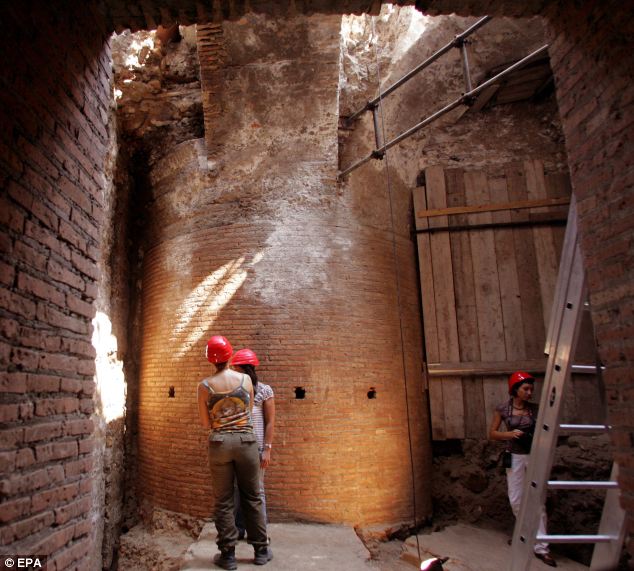 The best news about the re-opening of the Vigna Barberini is that during the excavations of 2009, the remains of Nero’s fabled rotating dining room of his 65AD Golden Palace were rediscovered. According to Suetonius, the tongue and cheek biographer of the Caesars, wrote that the circular room (the Coenatio Rotunda) revolved day and night, imitating the celestial bodies. Supposedly there were chambers under the floor that would be pushed along by flowing water. I inserted the photo taken from the archeological discovery. It’s a lot better than my photo. We were only allowed to see the pillar from above.
The best news about the re-opening of the Vigna Barberini is that during the excavations of 2009, the remains of Nero’s fabled rotating dining room of his 65AD Golden Palace were rediscovered. According to Suetonius, the tongue and cheek biographer of the Caesars, wrote that the circular room (the Coenatio Rotunda) revolved day and night, imitating the celestial bodies. Supposedly there were chambers under the floor that would be pushed along by flowing water. I inserted the photo taken from the archeological discovery. It’s a lot better than my photo. We were only allowed to see the pillar from above.
The 16m (53’) diameter room revolved around a 4m (13’) center pillar. At the top of the roof supports the archeologists discovered (5) 25cm (about an inch) holes filled with a dark substance thought to be metal fittings possibly used in the rotation of the ceiling panels. In my photo (see photo link at the end of the page) I was able to see the holes for metal fittings.
The domed ceiling moved around (supposedly) by slaves cranking some kind of rotating mechanism. According the Suetonius, ceiling panels occasionally slid back to allow flower pedals to fall or perfume to spray over the enchanted guests. Nero really knew how to throw a dinner party.
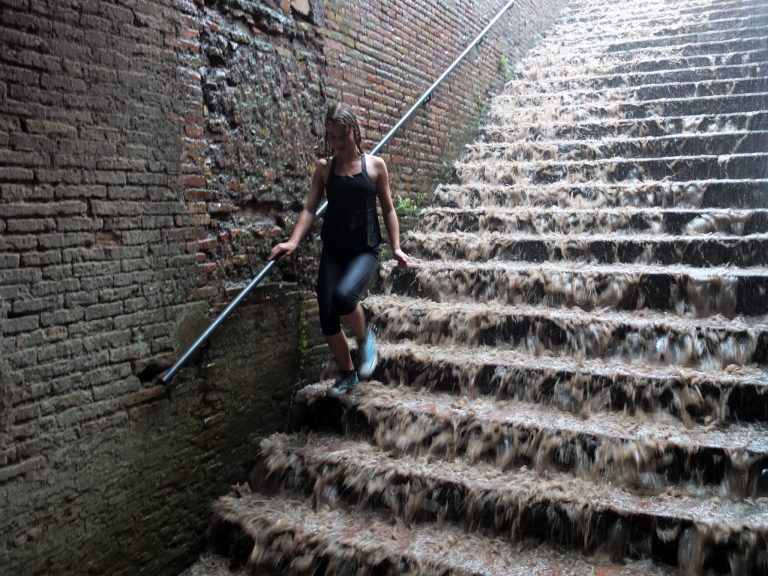 For a day with a 40% chance of showers, we were defenseless against what the Romans called “La Tempesta”, a tempestuous rainstorm of biblical proportions. We were caught for about an hour, huddled under one of the ancient arches of the Flavian Palace. Unfortunately, the water drainage of 2013 was worse than it was 2000 years ago. We ended up walking home in streets and paths of 6”-10” of water and spent the rest of the day in the warm apartment with our shoes drying out in the oven at a toasty 50°C (120° F).
For a day with a 40% chance of showers, we were defenseless against what the Romans called “La Tempesta”, a tempestuous rainstorm of biblical proportions. We were caught for about an hour, huddled under one of the ancient arches of the Flavian Palace. Unfortunately, the water drainage of 2013 was worse than it was 2000 years ago. We ended up walking home in streets and paths of 6”-10” of water and spent the rest of the day in the warm apartment with our shoes drying out in the oven at a toasty 50°C (120° F).
Every time we come to Rome we try to take in a local Italian show at the Chiostro di Bramante or one of the many 15th or 16th century Palazzi. Even if the exhibition isn’t that interesting, you still get to see the palazzo, which is usually well preserved.
We stopped into the Palazzo Venezia, the 15th century home of the Cardinal of Venice and the Headquarters of Mussolini’s Fascist Government. His famous balcony is still overlooking Piazza Venezia from the Map Room in the Palazzo.
We asked if we could see the Map Room if we bought a ticket to the Venanzio Crocetti sculpture exhibit and we were told yes, the exhibit was also in the map room. What we weren’t told was that the Map Room was covered up with 12’ tall exhibit panels. Oh well, the Crocetti show was fabulous.
Venanzio Crocetti (1913-2003) was an amazing sculptor I never knew about. He won the Grand prize of the Venice Biennale in 1936. In 1966, he finished his door of the sacraments on St Peter’s Basilica.
He was from Abruzzo. The only other Crocetti I even heard of was Dino Crocetti, also from Abruzzo. He turned out to be Dean Martin.
With every visit we also try to get out of the central historical zone.
 This time we made it up past the Gianicolo (Janicolo) Hill, to the Monteverde district of the Villa Doria Pamphilj Park adjacent to the 2nd century Aurelian walls and the Aqueduct Paolo (named for Pope Paul V Borghese). In 1605 Paul V restored the ancient 2nd century Aqua Traiana that was destroyed by the Ostrogoths in 537.
This time we made it up past the Gianicolo (Janicolo) Hill, to the Monteverde district of the Villa Doria Pamphilj Park adjacent to the 2nd century Aurelian walls and the Aqueduct Paolo (named for Pope Paul V Borghese). In 1605 Paul V restored the ancient 2nd century Aqua Traiana that was destroyed by the Ostrogoths in 537.
The Villa and grounds have been in the Pamphilj family since 1630 when it was purchased as a summer residence by Pamphilio Pamphilj, the brother of Pope Innocent X and the husband of Olimpia Maidalchino, “La Pimpaccia”, who became the power behind the Pope. In the 18th century of the Pamphilj girls married one of the Doria boys from Genoa (from the family of Andrea Doria) and the name was changed to Doria Pamphilj.
The landscaped gardens, the grotto and the villa known as the House of Beautiful Breath, are in a renewed state of beauty. The outdoor theater is still occasionally used for small concerts. The Byzantine Chapel on the grounds looks very 6th century but it was actually built in 1902.
The city of Rome bought the entire estate in 1965 and the park opened to the public in 1971. It’s the largest park in the city.
Before the city took it over it probably got vandalized a lot. Most of the statues had their heads removed. We’re not sure if the completed statues have had recent head transplants or if the “vandals” just missed a few. By the way, the Vandals, a 5th century Gothic tribe were Christians. In fact, Flavius Stilicho, the last great General magistrate of the Western Empire was of Vandal origin.
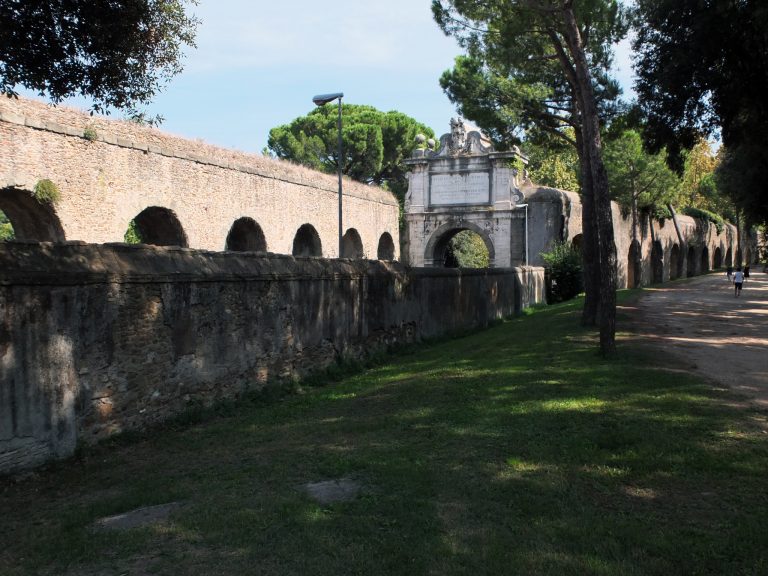 Today the park used mostly by joggers, and yes, Italian joggers can jog, talk on cell phones and text all at the same time.
Today the park used mostly by joggers, and yes, Italian joggers can jog, talk on cell phones and text all at the same time.
A small villa near the horse stables is now known as Casa dei Teatri . We saw an exhibit of mechanical Stage scenery here. The exhibition was designed, built and curated (and guided) by theater designer and research master Luciano Minestrella, now the Director of the Mirablilis Theatre. He was once the scenic director of the Teatro Argentina. His love of ancient mechanical theatrical devices has put him on a new quest of creating scale models based on the ancient designs of Leonardo Da Vinci to new esoteric interpretations of James Joyce’s “Ulysses” or an interpretation of the Palestinian Israeli conflict as a modern retelling of the Biblical tale of David and Goliath. Some of the mechanical models were concepts, some of them were built in full scale and presented to large audiences.
We walked back through the Porta San Pancrazio, where the Italians led by Giuseppe Garibaldi held off the French invaders in 1849.
The Pope was briefly replaced by the ‘Roman Republic’ in 1849 and the French forces invaded the city to put the Pope back in power. The original Porta San Pancrazio was destroyed in the battle, The French won, the Pope returned and a new gate was built.
In 1870, Garibaldi came back to Rome. This time he won. Rome became part of the Unified Italy and the Pope remained as the head of the Roman Catholic Church in the Vatican City.
We walked down the Gianicolo Hill (Janiculum Hill) past the terminus fountain of the Aqueduct Paolo where wedding couples were posing by the amazing view above the city. We walked over to the St Pietro in Montorio, once thought to be the location of the crucifixion of St Peter although the majority now agree that he was crucified between two obelisks in the Spina of the Circus of Caligula. We stopped off to see Bramante’s Tempietto, his very early 16th century mini tomb commissioned by Isabella and Ferdinand of Spain in 1502. It’s still one of the greatest architectural buildings of the Renaissance.
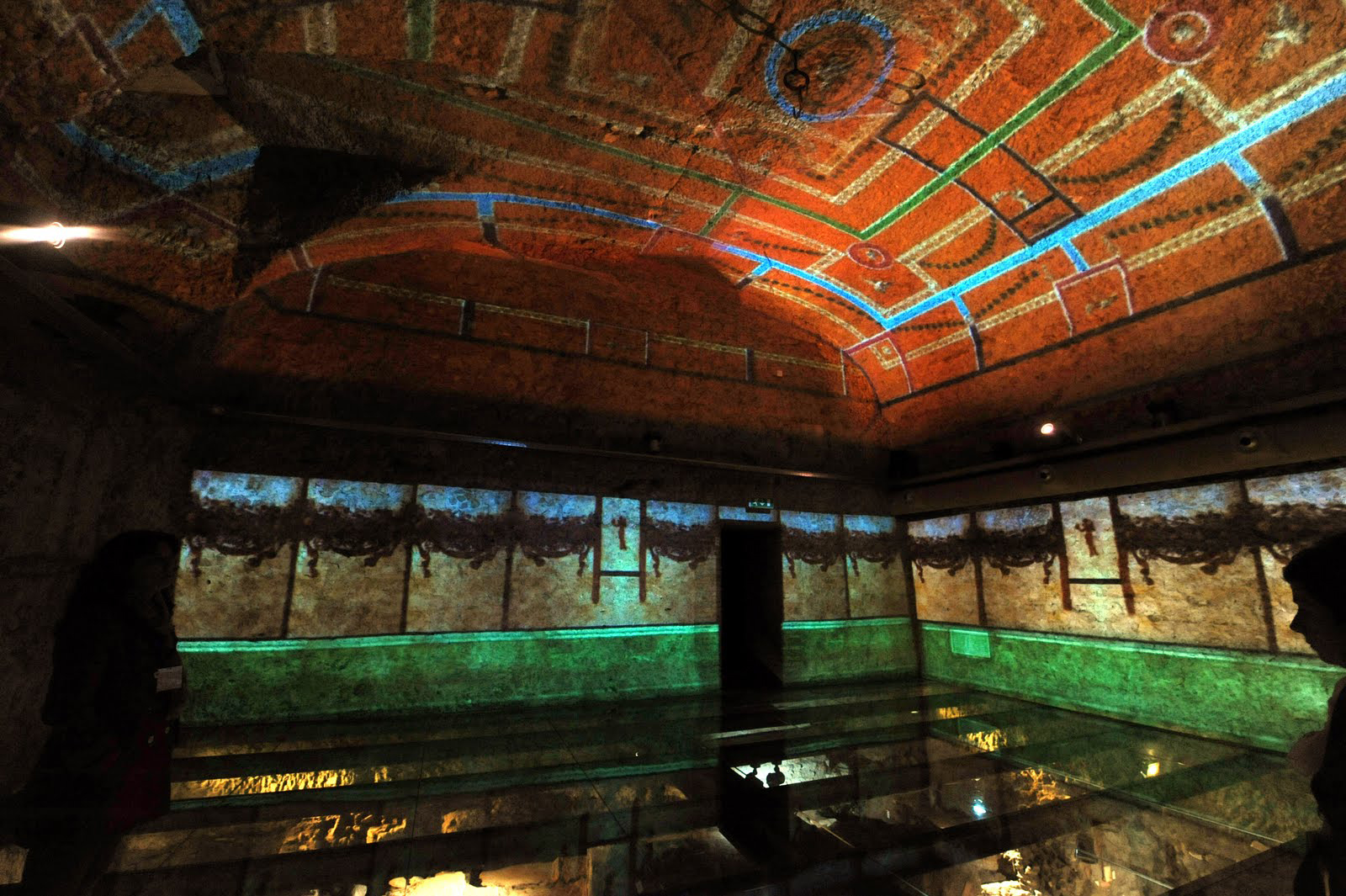 Our last new discovery on this visit was “Le Domus Romane”, the remains of a 1st century home of a very wealthy Roman family discovered beneath the 16th century Palazzo Valentini. The entrance to the Palazzo is on Via IV Novembre, the street named for the World War I Unknown Soldier buried in the Monument of Vittorio Emanuele II on November 4, 1921. The rear side of Palazzo Valentini is adjacent to Trajan’s Forum.
Our last new discovery on this visit was “Le Domus Romane”, the remains of a 1st century home of a very wealthy Roman family discovered beneath the 16th century Palazzo Valentini. The entrance to the Palazzo is on Via IV Novembre, the street named for the World War I Unknown Soldier buried in the Monument of Vittorio Emanuele II on November 4, 1921. The rear side of Palazzo Valentini is adjacent to Trajan’s Forum.
The Domus Romane opened in 2010. This is no ordinary villa. It had an enormous private bath house, private gymnasium, and two floors of rooms, courtyards and servants quarters. It’s an amazing find and an even more amazing exhibition, using the full extent of computer graphics and video mapping to fill in the ruins with a very realistic look at what it all looked like in the 1st century. The recreation and script of the visit was under the guidance of noted Italian Science Journalist and TV science personality, Piero Angela. Tickets must be made by email or by phone and in advance. The ticket is and service charge. It’s an amazing good deal for this 2hr show.
The computer video mapping of the ancient Domus brings everything back to life. Stone floors are totally restored with special visual effects, frescos are repainted to walls and domed ceilings. Staircases and rooms are recreated using just a few ruins of the ancient home, taking the ruins and mapping the completed ancient house on top of them. What would normally take a very education imagination to see how the home once looked in the 1st century is now laid out completely in front of you, literally transporting you back 2000 years.
The tour stops for a 10 minutes break before going on to the second half.
First we walk through a perfectly preserved 1940’s World War II bomb bunker and then onto the remains of the Temple of Trajan.
Trajan’s Column sat between two libraries, one in Greek and one in Latin. The height of the Column represents the exact amount of the Quirinale Hill that was removed to build the Forum of Trajan. It was quite an undertaking.
In front of the Column was the super large Basilica Ulpia. To the rear of the Column was Trajan’s Temple, built in the 2nd century after his death by Hadrian. We knew the remains of the Temple were buried under the Palazzo Valentini and the Church of the Holy Name of Mary but we never thought there was an actual excavation trying to find it.
Inside the Baths of Diocletian museum near the Termini train station you can see a couple of the large animal heads that came from the Temple of Trajan, but until now, any other information of the temple was lost to antiquity.
This is a very exciting time to visit Rome. Indeed, everything old in new again.
To see more photos of our 2013 visit to Rome please CLICK HERE
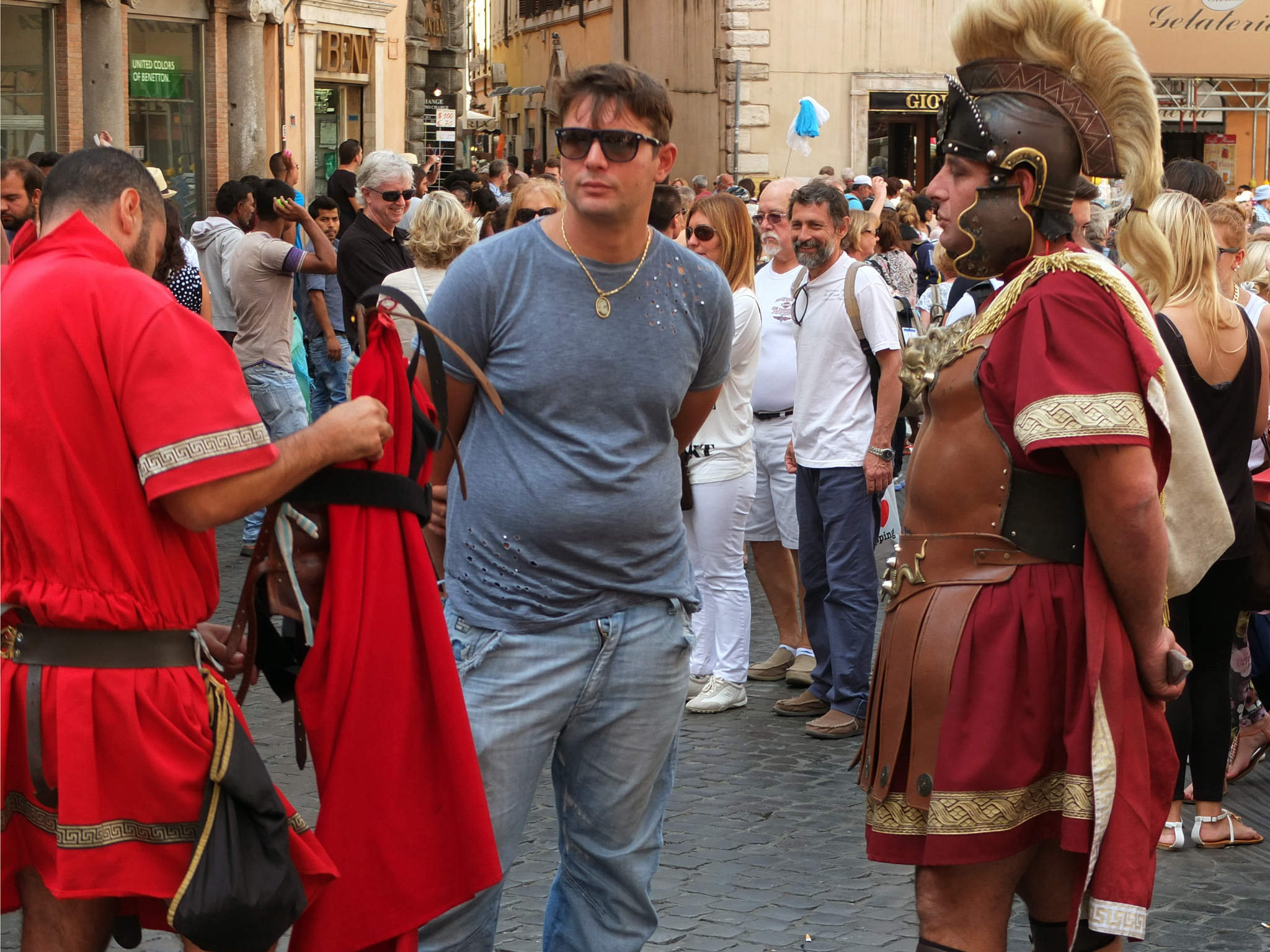
You must be logged in to post a comment.